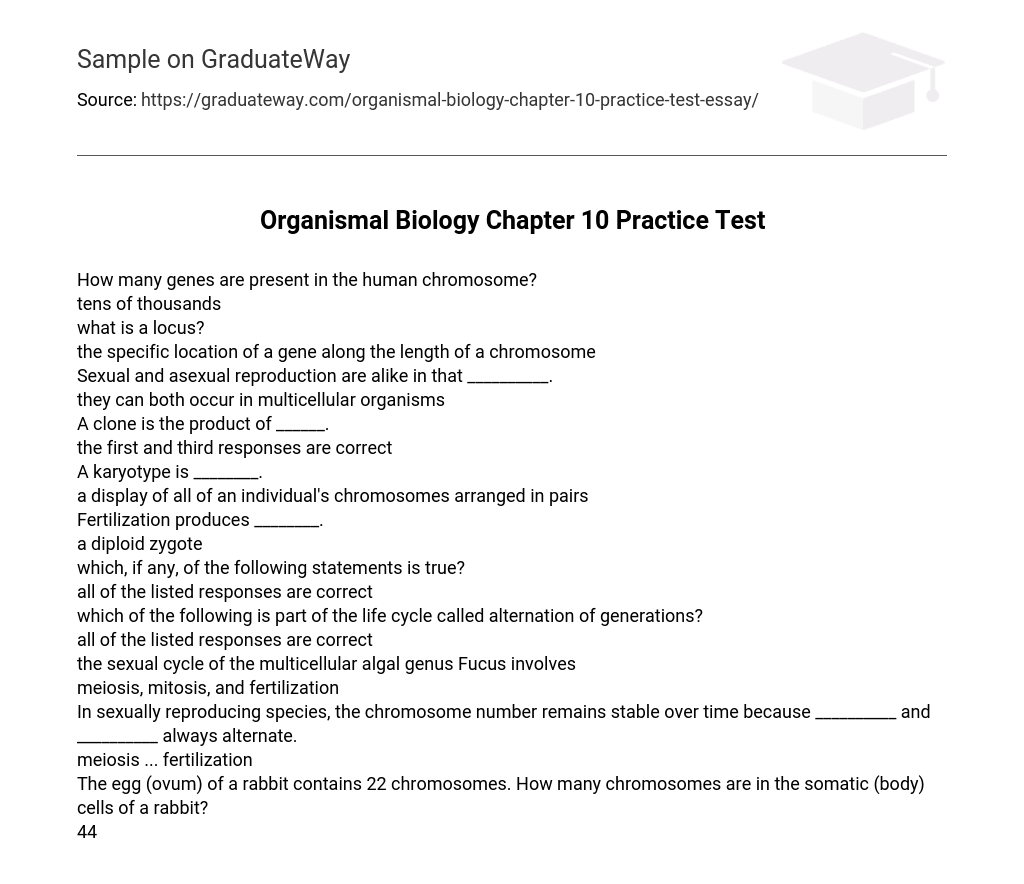How many genes are present in the human chromosome?
tens of thousands
what is a locus?
the specific location of a gene along the length of a chromosome
Sexual and asexual reproduction are alike in that __________.
they can both occur in multicellular organisms
A clone is the product of ______.
the first and third responses are correct
A karyotype is ________.
a display of all of an individual’s chromosomes arranged in pairs
Fertilization produces ________.
a diploid zygote
which, if any, of the following statements is true?
all of the listed responses are correct
which of the following is part of the life cycle called alternation of generations?
all of the listed responses are correct
the sexual cycle of the multicellular algal genus Fucus involves
meiosis, mitosis, and fertilization
In sexually reproducing species, the chromosome number remains stable over time because __________ and __________ always alternate.
meiosis … fertilization
The egg (ovum) of a rabbit contains 22 chromosomes. How many chromosomes are in the somatic (body) cells of a rabbit?
44
In a diploid cell containing 10 chromosomes, meiosis results in the formation of daughter cells containing __________ chromosomes.HINT
5
how many pairs of autosomes do humans have?
22
Sister chromatids ________.
are identical copies of each other formed during DNA synthesis
Humans have 46 chromosomes. This number of chromosomes will be found in __________.
liver cells
When we say that an organism is haploid, we mean that __________.
its cells have a single set of chromosomes
which of the following is a function of mitosis in humans?
multiplication of body cells that are genetically identical to the parent cell
Somatic cells in humans contain __________ set(s) of chromosomes and are therefore termed __________.
two … diploid
Nearly all life cycles have both haploid and diploid phases. Usually, the transition from haploid to diploid takes place __________.
at fertilization when gametes fuse
Spores and gametes are different in that __________.
gametes can fuse to form a zygote, but spores can develop into independent organisms without first forming a zygote
Which of the following results in cells that contain half the parental chromosome number?
meiosis
At the end of telophase I of meiosis and the first cytokinesis, there are __________.
two haploid cells
What is the result when a diploid cell undergoes meiosis?
four haploid cells
synapsis occurs during
prophase I
Which of the following occurs during anaphase II
sister chromatids separate and migrate toward opposite poles
Which of the following occurs during anaphase I
homologs separate and migrate towards opposite poles, guided by the spindle apparatus
what is the function of meiosis?
to make cells with a haploid number of chromosomes
Crossing over occurs during ________.
prophasere I
regions of chromosomes where nonsister chromatids cross over are called ________.
chiasmata
the synaptonemal complex
physically connects homologous chromosomes during prophase I
which event occurs only during prophase I of the first meiotic division?
synapsis of homologous pairs occurs
In a male mammal, every cell that undergoes meiosis gives rise to ________ sperm
four
which function makes meiosis lengthier and more complex than mitosis?
all of the listed responses are correct
Regarding the role of cohesin protein in maintaining cohesion between sister chromatids, which of the following statements is FALSE?
during meiosis II, cohesion holds sister chromatids along their lengths as the second meitotic spindle forms
Ignoring crossing over, how many kinds of gametes can be produced by an organism with a diploid number of 8?
16
which of the following contributes to genetic variation in sexually reproducing species
random fertilization, independent assortment, crossing over
In humans, the haploid number of chromosomes is 23. Independent assortment has the possibility pf producing ________ different types of gametes.
2^23
The diploid number of chromosomes in a certain animal is 8 (2n = 8). How do the four pairs of homologous chromosomes align and separate during meiosis?
They align and assort independently to form any of 16 different combinations.
In a diploid set of chromosomes, one member of each pair of homologous chromosomes is derived from the father (paternal), and the other comes from the mother (maternal). If 2n = 6, what is the probability of obtaining a gamete in which all the chromosomes are paternal ones?
1/8
the major contribution of sex to evolution is that ________.
it increases genetic variation
Which of the following answers is NOT involved with or an outcome of crossing over
the random alignment of homologous pairs of chromosomes at metaphase I
which of the following statements reflects an advantage that sexual reproduction likely provides over asexual reproduction?
although energetically more costly than asexual reproduction, sexual reproduction leads to different combinations of alleles that could provide adaptability in a changing environment
Although __________ is nearly universal among animals, bdelloid rotifers __________.
sexual reproduction … reproduce asexually but can increase genetic variation present in a population by means of the uptake of DNA from other rotifers
Remember! This essay was written by a student
You can get a custom paper by one of our expert writers
Order custom paper
Without paying upfront

